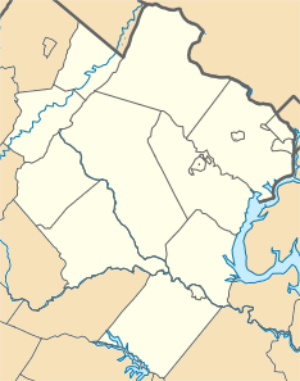Benjamin Banneker: SW-9 Intermediate Boundary Stone
|
Benjamin Banneker: SW 9 Intermediate Boundary Stone | |
|
SW9 Boundary Stone | |
   | |
| Location | 18th and Van Buren Sts., Arlington and Falls Church, Virginia |
|---|---|
| Coordinates | 38°52′58.6″N 77°9′32.6″W / 38.882944°N 77.159056°WCoordinates: 38°52′58.6″N 77°9′32.6″W / 38.882944°N 77.159056°W |
| Built | 1792 |
| NRHP reference # | 76002094 |
| Significant dates | |
| Added to NRHP | May 11, 1976[1] |
| Designated NHL | May 11, 1976[2] |
Benjamin Banneker: SW 9 Intermediate Boundary Stone, also known as an Intermediate Stone of the District of Columbia, is a surveyors' boundary marker stone, along what was once a boundary of Washington, DC, and now marks part of the boundary between City of Falls Church and Arlington County, Virginia (see: History of Washington, D.C.). It is within Arlington County's Benjamin Banneker Park at 6620 18th Street North.[3][4] It was named and was declared a National Historic Landmark in 1976 at the instigation of the Afro-American Bicentennial Corporation to honor Benjamin Banneker, who assisted in the land surveys that laid out Washington's boundaries.[2][5][6] The stone was the first of the District of Columbia boundary markers to be listed on the National Register of Historic Places.
Description and history
The boundary stone is a sandstone block about 1 foot (0.30 m) square in cross section, extending about 15 inches (38 cm) above ground and probably about 2 feet (0.61 m) below ground.[5] The top is rounded and worn.[5] Standardized inscriptions placed on each side of the stone are only partially visible, due in part to the stone's sinking over time.[3][5]
The words "Jurisdiction of the United States" are inscribed on the northeast side, which faced the federal territory (once the District of Columbia; now Arlington County). The opposite side now facing the City of Falls Church contains the remnant of the word "Virginia". Between those two sides, one side contains the year "1791", while the opposite side contains the remnant of an inscription recording the variation of the compass needle at the stone's location (indicated as "Var.").[7] A brass marker was once mounted top of the stone, placed in early 1900s by the Daughters of the American Revolution; it has since been removed.[5]
The stone is one of 40 boundary markers of the original District of Columbia.[3][4] Benjamin Banneker (1731-1806) was an African American surveyor, mathematician and astronomer who assisted Andrew Ellicott during the first three months of Ellicott's 1791-1792 survey of the boundaries of the original District of Columbia.[8]
See also
References
- ↑ National Park Service (2007-01-23). "National Register Information System". National Register of Historic Places. National Park Service.
- 1 2 "Banneker (Benjamin) SW-9 Intermediate Boundary Stone". National Historic Landmarks Program. National Park Service. Archived from the original on 2015-05-01. Retrieved 2017-01-29.
- 1 2 3 "The Banneker Stone (SW #9)". The Boundary Stones Project. Falls Church Chapter of the Daughters of the American Revolution. 2017-10-11. Retrieved 2017-06-01. Archived 2017-10-11 at the Wayback Machine.
- 1 2 "Benjamin Banneker Park". Department of Parks and Recreation, Arlington County, Virginia. Retrieved 2017-10-10. Archived 2017-10-10 at the Wayback Machine.
- 1 2 3 4 5 Graves, Lynne Gomez, Historical Projects Director, Afro-American Bicentennial Corporation, Washington, D.C (1976-02-03). "Benjamin Banneker: SW-9 Intermediate Boundary Stone (milestone) of the District of Columbia" (PDF). United States Department of the Interior: National Park Service: National Register of Historic Places Inventory––Nomination Form. Richmond, Virginia: Virginia Department of Historic Resources. Retrieved 2016-10-07. Archived 2016-10-01 at the Wayback Machine. and Accompanying three photos, undated (32 KB)
- ↑ "Benjamin Banneker: SW 9 Intermediate Boundary Stone". VIRGINIA - Arlington County. National Register of Historic Places.com. p. 1. Archived from the original on July 21, 2010. Retrieved 2013-01-05.
- ↑ (1) National Capital Planning Commission (1976). Boundary markers of the Nation's Capital: a proposal for their preservation & protection : a National Capital Planning Commission Bicentennial report. Washington, D.C.: National Capital Planning Commission; For sale by the Superintendent of Documents, United States Government Printing Office. p. 9. OCLC 3772302. Retrieved 2016-02-22.
At HathiTrust Digital Library
(2) "SW9". Boundary Stones of the District of Columbia. boundarystones.org. Archived from the original on 2016-10-15. Retrieved 2017-01-29. - ↑ Bedini, Silvio A. (1999). The Life of Benjamin Banneker: The First African-American Man of Science (2nd ed.). Baltimore: Maryland Historical Society. ISBN 0-938420-59-3. LCCN 98022848. OCLC 39024784. Retrieved 2017-05-31 – via Google Books.
| Wikimedia Commons has media related to Boundary Stone (District of Columbia) SW 9. |